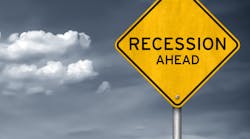© Waingro | Dreamstime
Oren Klachkin, Lead US Economist, for Oxford Economics released a statement on March 30, with his organization's third estimate for US GDP, Q4.
- The slight downward revision to Q4 GDP shows the economy ended 2022 with marginally less momentum. Looking ahead, the economy will face the full brunt of tighter credit conditions and Fed policy this year, and inflation is set to stay above its historical trend. The recent banking sector turmoil will affect the economy mainly through tighter lending standards and a reduction in the availability of credit. We expect a recession to hit in the second half of 2023, with a peak-to-trough GDP decline of around 1.5%.
- Real GDP grew 2.6% annualized in Q4 according to the third estimate, a touch below consensus expectations and down from the previous estimate of 2.7%. Lower consumer spending and exports drove the downward revision. Stripping out the volatile GDP components, the data show the economy was essentially flat in the final stages of 2022.
- Goods-producing industries led the expansion, while services grew relatively more slowly. Seventeen of the 22 major industry groups recorded gains, with durable goods manufacturing and mining adding the most among goods industries to the economic expansion, while the largest contribution among services came from business services, retail trade, healthcare, and information. Goods-producing industries are expected to incur more damage than services in the upcoming recession.
- The income-side of the economy offered a less encouraging view as real Gross Domestic Income (GDI) fell 1.1% annualized in Q4. Gross Domestic Output (GDO) – the average of GDP and GDI which tends to be a leading indicator – rose 0.7% in Q4 after a 3% gain in Q3.
- Before-tax corporate profits declined the most since Q4 2020, down $60.5bn in Q4 after a $1.3bn drop in Q3. Profit margins fell 0.5ppts to 11.2% of GDP last quarter, down from their 12.1% peak hit in Q3 2021.
Latest from News
Latest from News
Oct. 12, 2023
Sept. 27, 2023



